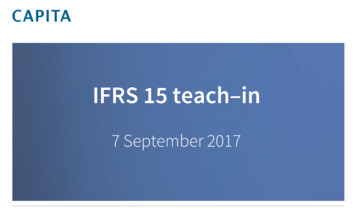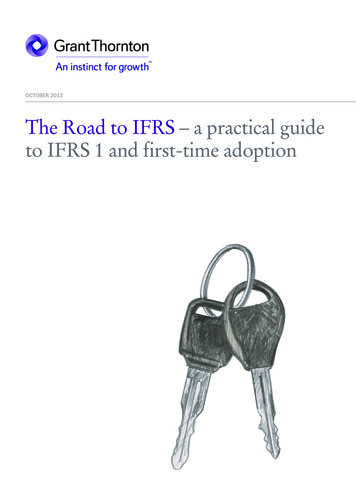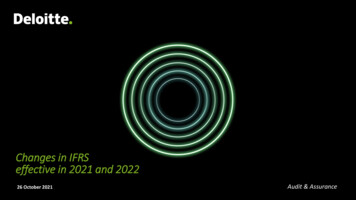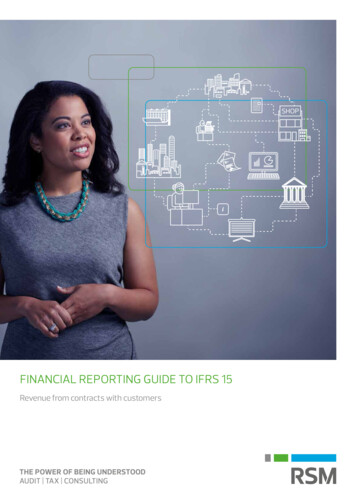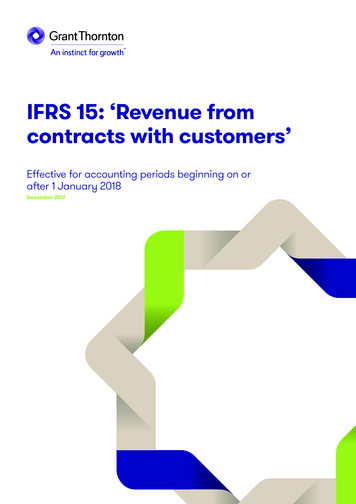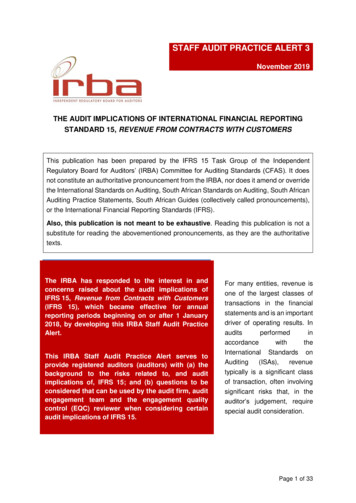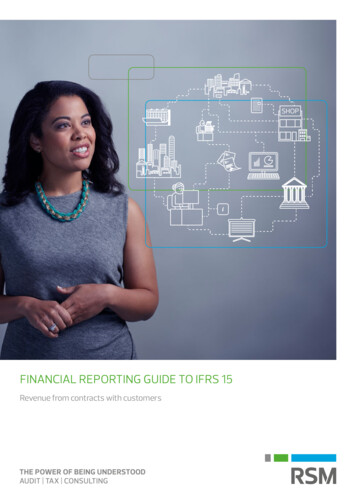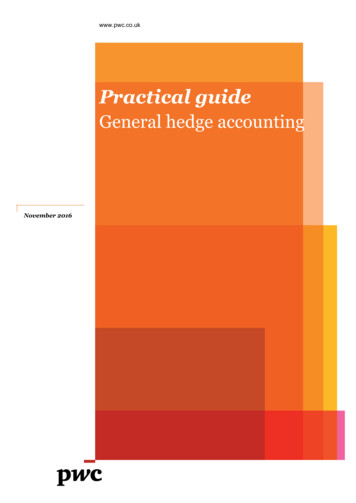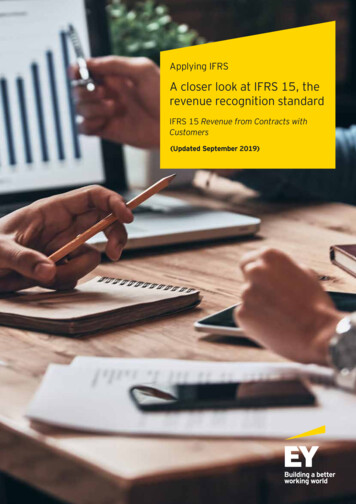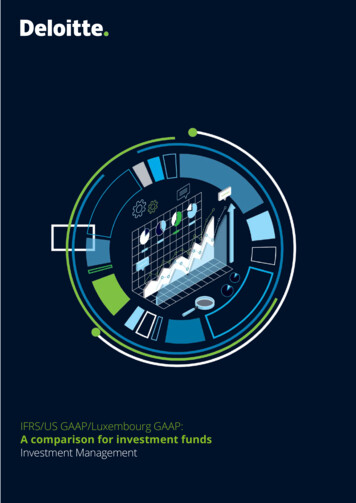
Transcription
IFRS/US GAAP/Luxembourg GAAP:A comparison for investment fundsInvestment Management1
Brochure / report title goes here Section title goes hereForeword03International updates04Industry-specific guidance for investment funds09Financial statement presentationand disclosure differences for investment funds12Selected accounting differencesthat impact investment funds0235
IFRS/US GAAP/Luxembourg GAAP: a comparison for investment fundsForewordWe are pleased to present the 4th edition ofthis publication comparing the application ofmajor generally accepted accounting principles(GAAP) for investment funds—IFRS/USGAAP/Luxembourg GAAP.The investment management industryfaces an ever-increasing demand fortransparency by stakeholders. This isfurther amplified in times of crisis. Asinvestment managers look foropportunities to enter global markets,it is essential that any reporting totheir stakeholders on their strategiesand products, including through theirfinancial statements, is clearlyunderstood, meets localrequirements, and allows forcomparison between the manyinvestment products offered.Although the ambition to move toward aset of globally accepted financial reportingstandards, which address the needs ofstakeholders and acknowledge the uniquenature of the fund accounting industry,remains an ideal, different accountingstandards are still used for preparing thefinancial statements of investment fundsglobally.This document highlights selecteddifferences between the major sets ofaccounting standards (IFRS, US GAAP andLuxembourg GAAP) applied to investmentfunds. Although there are other significantglobal investment fund jurisdictions, theaccounting standards in those other areastend to allow or closely follow the tenets ofIFRS.This summary does not attempt to captureall of the differences that exist or that maybe material to a particular fund’s financialstatements. Our focus is on differencesthat are often encountered in practice.Further, the significance of thesedifferences—and others not included inthis analysis—will vary with respect toindividual entities, depending on suchfactors as the nature of the fund'soperations, the asset class in which itinvests, and the accounting policy it haschosen. As a result, reference to theunderlying accounting standardsis key in understanding thespecific differences. Althoughgreat care has been given tothe drafting of this publication, DeloitteAudit and the authors will take noresponsibility for any omissions orinaccuracies.We hope that you find this comparisonhelpful and encourage you to contact us forfurther discussions or additionalinformation.Best,Justin GriffithsPartn er, InvestmentVincent GouverneurPartner, Investment Management Leader3
IFRS/US GAAP/ Luxembourg GAAP: a comparison for investment fundsInternationalupdatesWe have created this briefing to provide anoverview of the potential accounting differencesthat exist between International Financial ReportingStandards (“IFRS”), generally accepted accountingprinciples in the United States (“US GAAP”) andLuxembourg generally accepted accountingprinciples (“LUX GAAP”) when applied to investmentfunds.While US GAAP and IFRS are wellestablished and recognized sets ofaccounting standards, LUX GAAP forinvestment funds is derived fromLuxembourg laws and regulations, and isprimarily shaped by the European Union(EU) Undertakings for CollectiveInvestment in Transferable Securities(UCITS) Directive and the AlternativeInvestment Fund Manager (AIFM) Directive.4Before presenting our analysis of theselected differences, we highlight belowcertain recent developments affectinginvestment funds in the sets of accountingstandards under consideration.
IFRS/US GAAP/Luxembourg GAAP: a comparison for investment fundsIFRSUPDATESIFRS 16 & Covid-19-Related RentConcessionsIFRS 16 Leases replaced the existingstandard IAS 17 Leases becomingeffective for reporting periods beginningon or after 1 January 2019.For lessors, the changes introduced byIFRS 16 are not significant and, except inrespect of subleases, a lessor is notrequired to make any adjustments ontransition for leases in which it is a lessor.For lessees, the picture is fundamentallydifferent. All leases within the scope ofIFRS 16 (except for short-term leases, i.e.,a lease term of 12 months or less, andleases of low-value assets) are requiredto be brought on-balance sheet bylessees, recognizing a right-of-use assetand the related lease liability atcommencement of the lease, withsubsequent accounting generally similarto the finance lease model under IAS 17.Following the Covid-19 pandemic, theIASB published an amendment entitledCovid-19- Related Rent Concessions,which permits lessees, as a practicalexpedient, not to assess whetherparticular rent concessions occurring asa direct consequence of the Covid-19pandemic are lease modifications andinstead to account for those rentconcessions as if they are not leasemodifications. The amendment does notaffect lessors. This amendment iseffective for reporting periods beginningon or after 1 June 2020 with earlierapplication permitted and was endorsedby the European Union (EU) in October2020.IFRS 9/IAS 39 IBOR Reform and itseffect on financial reportingFollowing the Financial Stability Board’sreport setting out recommendations toreform some major benchmarks(interbank offer rates [IBORs]), the IASBconsidered the financial reportingimplications of the uncertainties aboutthe future of existing interest ratebenchmarks and identified two groups ofaccounting issues that could havefinancial reporting implications. Theseare: Phase 1: pre-replacement issues—issues affecting financial reporting inthe period before the replacementof an existing interest ratebenchmark with an alternative rate;and Phase 2: replacement issues—issuesthat might affect financial reportingwhen an existing interest ratebenchmark is replaced with analternative rate.In respect of Phase 1, on 26 September2019 the IASB issued the Interest RateBenchmark Reform (Amendments toIFRS 9, IAS 39 and IFRS 7), applicablefrom 1 January 2020 (early adoptionpermitted), which amends some of theexisting IFRS requirements for hedgeaccounting.The amendments apply solely to hedgeaccounting requirements that are basedon forward-looking analysis and are asfollows: Assume that the interest ratebenchmark on which hedged cashflows are based is not altered as aresult of the reform in the probabilityassessment of a forecast transaction; Assume that the interest ratebenchmark on which the hedgeditem, hedged risk and/or hedginginstrument are based is not alteredas a result of the interest ratebenchmark reform in making theprospective assessment underhedge accounting; Grant relief from the IAS 39 (80125%) retrospective assessment forhedging relationships directlyimpacted by the reform on certainconditions; For hedges of a non-contractuallyspecified benchmark component ofinterest rate risk, a company shallapply the separately identifiablerequirement only at the inception ofsuch hedging relationships; andDefine the rules in relation to therelief granted under the temporaryexemptions from applying specifichedge accounting requirementsduring the period of uncertaintyregarding reform.The amendments are also designed tosupport the provision of useful financialinformation during the period ofuncertainty.The IASB has issued the Interest RateBenchmark Reform – Phase 2amendment which amends IFRS 9Financial Instruments, IAS 39 FinancialInstruments: Recognition andMeasurement, IFRS 7 FinancialInstruments: Disclosures, IFRS 4Insurance Contracts, and IFRS 16 Leases.The amendment addresses the followingareas: Practical expedient for particularchanges to contractual cash flows; Relief from specific hedgeaccounting requirements; Disclosure requirements; and Transition and effective date.This amendment has not yet beenendorsed by the EU at the date ofpublication of this report.5
IFRS/US GAAP/Luxembourg GAAP: a comparison for investment fundsExposure Draft: Primary FinancialStatementsIn December 2019, the IASB publishedan Exposure Draft setting out proposalsfor a draft IFRS Standard onpresentation and disclosures in financialstatements that, if finalized, will replaceIAS 1 Presentation of FinancialStatements. The proposals require: Additional subtotals in the statementof profit or loss for transparency,consistency and comparability. The disaggregation of: operatingexpenses either by nature or byfunction in the statement of profit orloss; large “other” balances; andinformation regarding unusualincome and expenses and additionalminimum line items in the statementof financial position. Disclosure of some managementdefined performance measures—that is, performance measures notspecified by IFRS Standards—withreconciliations between these andsubtotals specified by IFRSStandards. Limited changes to the statement ofcash flows.6
IFRS/US GAAP/Luxembourg GAAP: a comparison for investment fundsUS GAAPUPDATESIn August 2018, the FASB issuedASU 2018-03, which removes,modifies, and adds disclosurerequirements on fair valuemeasurements in Topic 820, FairValue Measurements. Thepurpose is to improve theeffectiveness of these disclosurerequirements.The amendments to the fair valuemeasurement disclosure requirementsinclude those listed below. The applicabilityof the changes to a particular entity maydepend on whether it is considered a nonpublic entity.New disclosure requirements: Changes in unrealized gains or lossesincluded in other comprehensiveincome (OCI) for recurring Level 3 fairvalue measurements held at the end ofthe reporting period; and Range and weighted average used todevelop significant unobservable inputsfor Level 3 fair value measurements.The aforementioned new disclosurerequirements are not applicable tonon-public entities.Modified disclosure requirements: Transfers into and out of Level 3 andpurchases and issues of Level 3 assetsand liabilities, disclosed in lieu ofreconciling the opening balances to theclosing balances of recurring Level 3 fairvalue measurements; Clarification that the measurementuncertainty disclosure is tocommunicate information about theuncertainty in measurement as of thereporting date; andModified disclosure requirements(continued): For investments in certain entitiesthat calculate net asset value(NAV), a requirement to disclosethe timing of liquidation of aninvestee’s assets and the datewhen restrictions fromredemption might lapse only if theinvestee has communicated thetiming to the entity or announcedthe timing publicly.Eliminated disclosure requirements: Amount of and reasons for transfersbetween Level 1 and Level 2; Valuation processes for Level 3 fairvalue measurements; Policy for timing of transfers betweenlevels of the fair value hierarchy; and Changes in unrealized gains andlosses for the period included inearnings for recurring Level 3 fairvalue measurements held at the endof the reporting period.This ASU is effective for all entities for fiscalyears beginning after 15 December 2019,including interim periods therein.Further US GAAP updates impacting theinvestment management industry can befound in the 2018 edition of our annualupdate highlighting selected accounting andreporting developments, at the link unting-and-financialreporting-update-2018.html7
IFRS/US GAAP/Luxembourg GAAP: a comparison for investment fundsUPDATES WITH IMPLICATIONSFOR LUX GAAPIn 2019, the European Securities andMarkets Authority (ESMA) publishedupdated questions and answersdocuments (Q&A) on the applicationof the Undertakings for the CollectiveInvestment in Transferable SecuritiesDirective (UCITS) and the AlternativeInvestment Fund Managers Directive(AIFMD).The UCITS Q&A included new questionsand answers on: Application of disclosure requirementson the remuneration of delegates; and The depositary regime.8The AIFMD Q&A included newquestions and answers on: Calculation of the leverage of eachAIF that the AIFM manages; and The depositary regime.Links to these Q&As can be found rs.In April 2020, ESMA issued guidelines onperformance fees for UCITS and certaintypes of retail AIFs which are applicabletwo months after publication of thetranslation into the official EU languages.ESMA published the translations onNovember 5, 2020.Link library/esma 34-39968 final report guidelines on performance fees.pdf
IFRS/US GAAP/Luxembourg GAAP: a comparison for investment fundsIndustry-specificguidancefor investment funds9
IFRS/US GAAP/Luxembourg GAAP: a comparison for investment fundsIFRSIFRS do not provide specificguidance for registered investmentcompanies or private funds.Currently, an investment companymust follow the generic IFRS.For guidance on industry-specific issues,investment companies following IFRS maylook to IFRS guidance dealing with similarissues, the current conceptual framework,standards of other standard-settingbodies and, in certain instances, acceptedindustry practices.The IASB however, recognizes the conceptof an investment entity (IE) in IFRS 10,which provides an exemption from therequirement to consolidate subsidiariesfor eligible investment entities, insteadrequiring such investments to be10measured at fair value.However, an investment entity is stillrequired to consolidate a subsidiary thatprovides services that relate to theinvestment entity’s investment activities.IFRS 10 defines an "investment entity" (IE)as an entity that:Additionally, an IE would typically havethe following characteristics (althoughthe absence of any of these would notdisqualify it from being classified as anIE): More than one investor; Obtains funds from one or more investor forthe purpose of providing those investor(s)with investment management services; More than one investment; Commits to its investor(s) that its businesspurpose is to invest funds solely for returnsfrom capital appreciation, investment income,or both; and Ownership interests in the form ofequity or similar interests. Measures and evaluates theperformance of substantially all of itsinvestments on a fair value basis Investors that are not related parties;and
IFRS/US GAAP/Luxembourg GAAP: a comparison for investment fundsUS GAAP/SECSpecific guidance is available forinvestment companies, principallythrough the FASB's AccountingStandards Codification (ASC) 946Financial Services-InvestmentCompanies (Topic 946).Additionally, the AICPA Audit andAccounting Guide for InvestmentCompanies provides a comprehensivesource of information about operatingconditions and auditing procedures uniqueto the investment company industry.Further, the AICPA Technical Practice Aidsection 6910 provides questions andanswers on certain matters related toinvestment companies. These questionsand answers are non-authoritative. Thematerial is based on selected practicematters related to investmentcompanies that were identified by thestaff of the AICPA's Technical Hotlineand various other bodies within theAICPA.The Investment Company Act of 1940 andRegulations S-X provide specific guidanceand regulation for investment companiesregistered with the Securities ExchangeCommission (SEC).ASC 946 requires similar characteristicsto be evaluated in determining if an entityis considered an investment companyunder US GAAP as are evaluated underIFRS. However, there are differencesrelated to some of the fundamental andtypical characteristics. The fact that the entity is an investmentcompany and is applying the guidance inASC 946; Information regarding any changesin an entity's status as an investmentcompany; and Information about financial supportprovided or contractually requiredto be provided by an investmentcompany to any of its investees.This ASC clarifies the criteria for an entityto be considered an investment companyand therefore required to measure noncontrolling ownership interests in otherinvestment companies at fair value ratherthan using the equity method ofaccounting, and to include the followingdisclosures:LUX GAAPSpecific guidance is available forinvestment companies. This guidance is mainly found in:(i) The following laws and regulations inLuxembourg: The Law of 17 December 2010 onUndertakings for CollectiveInvestment (UCI), as amended; The Law of 13 February 2007 on Specialized Investment Funds(SIF), as amended; The Law of 12 July 2013 on Alternative Investment FundManagers, as amended; Circulars issued by the LuxembourgCommission de Surveillance duSecteur Financier (CSSF); and(ii) The requirements of the followingEuropean Directives: The UCITS Directive (Directive85/611/EEC replaced byThe Law of 23 July 2016 on reservedalternative investment funds (RAIF).Directive 2009/65/EC); and The AIFM Directive (2011/61/EU).(iii) Guidelines issued by the Associationof theLuxembourg Fund Industry (ALFI).(iv) Guidelines and Q&As issued by theEuropeanSecurities and Markets Authority(ESMA). The link to these Q&As can befound ers.(v) Certain opinions of the LuxembourgCommissions des Normes Comptables(CNC): CNC Notice 09/002 on theInterpretation of Article 1711-8(3)(c)LSC in the specific case of venturecapital/private equity investmentcompanies.(vi) Guidance provided to members bythe Luxembourg Institute of StatutoryAuditors (L’Institute des Réviseursd’Entreprises - IRE).11
IFRS/US GAAP/Luxembourg GAAP: a comparison for investment fundsFinancialstatementpresentationand disclosuredifferencesfor investment funds12
IFRS/US GAAP/Luxembourg GAAP: a comparison for investment fundsComponents offinancial statementsIFRS01. Statement of financial position.02. Statement of profit or loss and othercomprehensive income (or twoseparate statements).03. Statement of changes in equity (orstatement of changes in net assetsattributable to holders of redeemableshares if there is no equity).04. Statement of cash flows.05. Notes, comprising a summaryof accounting policies andother explanatory notes.US GAAP/SEC01. Statement of assets and liabilities with aschedule of investments or a statementof net assets, which includes a scheduleof investments therein.02. Statement of operations.03. Statement of changes in net assetsor statement of changes in partners'/members' capital/equity (dependingon structure).04. Statement of cash flows (unlessexempted under US GAAP).05. Financial highlights for the latestperiod consisting of net investmentincome and expense ratios, and thetotal return or internal rate of return.Per share operating performanceis also required for all investmentcompanies organized in a mannerusing unitized net asset value.SEC registered funds should alsodisclose the portfolio turnover.06. Notes to the financial statements.LUX GAAP01. Statement of assets and liabilities (ornet assets), including a schedule ofinvestments (UCI), or qualitative and/or quantitative information regardingthe investment portfolio (SIF and RAIF).02. Statements of operations.03. Statement of changes in net assets.04. A comparative table with period-end netasset value data for the last three years.05. Notes to the financial statements.06. Report on the activities of thefinancial year. The regulationsupplementing the AIFMD stipulatesthe disclosure required for AIFs. Seethe ALFI Code of Conduct forguidance on Board Reports.13
IFRS/US GAAP/Luxembourg GAAP: a comparison for investment fundsStatement of profit and lossand other comprehensiveincome/ operationsIFRSCertain line items are required to bepresented on the face of the statementof comprehensive income. Additionalline items should be presented whensuch presentation is relevant to theunderstanding of the entity’s financialperformance.Expenses are presented based either ontheir nature or function within the entity.US GAAP/SECThe excess of investment income overtotal expenses should be shown as netinvestment income (or loss). The netrealized gain or loss from investmentsand foreign currency transactionsshould be disclosed. The net increase(decrease) in unrealized appreciation ordepreciation on investments and thetranslation of assets and liabilities inforeign currencies should be disclosed.LUX GAAPCertain line items are required tobe presented on the face of thestatement of operations.14Expenses are presented basedon their nature. Funds registered withthe SEC should review the InvestmentCompany Act of 1940 and RegulationS-X for requirement
IFRS/US GAAP/Luxembourg GAAP: a comparison for investment fundsSchedule of investmentsIFRSDisclosure of a schedule(or a condensed schedule) ofinvestments is not required.IFRS 13 Fair Value Measurementhowever requires certain disclosures byclass for financial assets and liabilitiesmeasured at fair value, including: The fair value of that class; The level of the fair value hierarchywithin which the fair valuemeasurements are categories intheir entirety (Level 1, 2, or 3); Information regarding transfersbetween Level 1 and Level 2 of thefair value hierarchy; A description of the fair valuationtechniques and the inputs used in thefair value measurements categorizedwithin Level 2 and Level 3 of the fairvalue hierarchy; andIFRS 7 requires disclosure of thecarrying amount of the financialassets an entity has pledged ascollateral for liabilities orcontingent liabilities.IFRS 12 also requires disclosureof the following for eachunconsolidated subsidiary: The subsidiary’s name; The principal place of business;and The proportion of ownershipinterest held.If an investment entity is theparent of another investmententity, the parent is required todisclose the abovementionedinformation for investments thatare controlled by the investmententity subsidiary For fair value measurementswithin Level 3 of the fair valuehierarchy, additional disclosuremay include:01. A reconciliation between theopening and closing balances,02. A description of the valuationprocesses, and03. A narrative description of thesensitivity of the fair valuemeasurement to changes inunobservable inputs (including theeffect of changes to reflectreasonably possible alternativeassumptions that would change thefair value significantly)15
IFRS/US GAAP/Luxembourg GAAP: a comparison for investment fundsUS GAAP/SECDisclosure of a schedule ofinvestments (required for SECregistered funds) or a condensedschedule of investments isrequired.A. Categorize investments by all ofthe following:01. Type (such as common stocks,preferred stocks, convertiblesecurities, fixed-income securities,government securities, optionspurchased, options written,warrants, futures, loanparticipations, short sales, otherinvestment companies, and soforth).02. Country or geographic region,except for derivative instrumentsfor which the underlying is not asecurity.03. Industry, except for derivativeinstruments for which theunderlying is not a security.04. For derivative instruments forwhich the underlying is not asecurity, by broad category ofunderlying (for example, grains andfeeds, fibers and textiles, foreigncurrency, or equity indexes) inplace of the categories in (A)(02)and (A)(03).B. Report the percent of netassets that each such categoryrepresents and the total fair valueand cost for each category in (A)(01)and (A)(02)C. Disclose the name, number ofshares or principal amount, fairvalue, and type of both of thefollowing:1601. Each investment (including shortsales) constituting more than 5% ofnet assets, except for derivativesinstruments (see (E) and (F)). Inapplying the 5% test, total long andtotal short positions in any oneissuer shall be consideredseparately.02. All investments in any one issueraggregating more than 5% of netassets, except for derivativeinstruments (see (E) and (F)). Inapplying the 5% test, total long andtotal short positions in any one issuershall be considered separately.D. Aggregate other investments(each of which is 5% or less of netassets) without specifically identifyingthe issuers of such investments andcategorize them in accordance withthe guidance in (A). In applying the5%, total long and total shortpositions in any one issuer shall beconsidered separately.E. Disclose the number of contracts,range of expiration dates, andcumulative appreciation(depreciation) for open futurescontracts of a particular underlying(such as wheat, cotton, specifiedequity index, orUS Treasury Bonds), regardless ofexchange, delivery location, or deliverydate, if cumulative appreciation(depreciation) on the open contractsexceeds 5% of net assets. In applyingthe 5% test, total long and total shortpositions in any one issuer shall beconsidered separately.F. Disclose the range ofexpiration dates and fairvalue for all other derivativeinstruments of a particularunderlying (such as foreigncurrency, wheat, specified equityindex, orUS Treasury Bonds) regardless ofcounterparty, exchange, ordelivery date, if fair value exceeds5% of net assets. In applying the5% test, total long and total shortpositions in any one issuer shallbe considered separately.G. Provide both of the followingadditional qualitativedescriptions for eachinvestment in anothernonregistered investmentpartnership whose fair valueconstitutes more than 5% of netassets:01. The investment objective; and02. Restrictions on redemption(that is, liquidity provisions).Funds registered with the SECshould review the InvestmentCompany Act of 1940 andRegulation S-X for requirements.
IFRS/US GAAP/Luxembourg GAAP: a comparison for investment fundsLUX GAAPDisclosure of a schedule of investments isrequired (except for a SIF and RAIF, whichmay present qualitative information onthe investment portfolio as analternative).The schedule of investments must distinguishbetween transferable securities and moneymarket instruments that are: Admitted to an official stock exchange listing; Dealt in on another regulated market; Recently issued; andA statement of changes in thecomposition of the portfolio during thereference period is also required(however, in practice a note is added toexplain that this information is availableupon request at the registered office ofthe fund).Details by category of derivativeinstruments and efficient portfoliomanagement techniques utilized by theUCITS, and the resulting exposure levels. Other transferable securities and moneymarket instruments.In practice, the first three bullets aremerged in the schedule of investments,and may be analyzed in accordance withthe most appropriate criteria based onthe fund’s investment policy (e.g. inaccordance with economic, geographicor currency criteria.17
IFRS/US GAAP/Luxembourg GAAP: a comparison for investment fundsStatement of cash flowsIFRSRequired for all investment funds.The cash flows reported during the periodare classified by operating, investing, andfinancing activities. Cash flows fromoperating activities can be reported usingeither the direct method or the indirectmethod.Interest and dividend income/expenses,interest, and dividends actuallyreceived/paid (as opposed to accrued)are shown separately in the statement ofcash flows.Cash flows arising from taxes on incometaxes are separately disclosed and areclassified as cash flows from operatingactivities, unless they are specificallyidentified with financing and investingactivities.The impact of exchange ratemovements on cash and cashequivalents held or due in foreigncurrencies is reported in thestatement of cash flows in order toreconcile cash and cash equivalents atthe beginning and end of the period.US GAAP/SECAn investment company may beexempted from presenting astatement of cash flows if certainconditions are met. Theconditions, in accordance withTopic 230, are:1.An investment company carriessubstantially all of its investments atfair value and classifies them inaccordance with Topic 820 as Level 1or Level 2 in the fair value hierarchytable, or measures them using thepractical expedient in paragraph 82010-35-59 to determine their fairvalues and these are redeemable inthe near term at all times;2.An investment company haslittle or no debt, based on theLUX GAAPNo requirement for a statement of cash flows.18average debt outstandingduring the period, in relation tothe average total assets; and3.An investment companyprovides a statement ofchanges in net assets.Should a cash flow statement berequired, the direct or indirectmethod is permitted.
IFRS/US GAAP/Luxembourg GAAP: a comparison for investment fundsFinancial highlightsIFRSIFRS do not require a presentation offinancial highlights. Nevertheless, IFRSrequire additional disclosure whencompliance with specificrequirements under IFRS is insufficientto enable users to understand thecorresponding impact.US GAAP/SECThe disclosure of financial highlightsis required under US GAAP, for eachclass of common shares that are not amanagement class, either as aseparate schedule, or within the notesto the financial statements.For SEC registered funds, the financialhighlights should be presented in aschedule for the last five fiscal years.Unitized and non-unitized funds,limited-life and perpetual life fundshave different disclosure requirements.LUX GAAPDisclosure is required of thefollowing statistics for each of the lastthree financial year-ends: The total net asset value.The net asset value per share foreach class of share.19
IFRS/US GAAP/Luxembourg GAAP: a comparison for investment fundsComparativesIFRSIFRS requires comparative information tobe presented in respect of the precedingperiod for all amounts reported in thecurrent period's financial statements.of financial position at the beginning ofthe preceding period, a third statementof financial position as at the beginningof the preceding period is required.When an accounting policy has beenapplied retrospectively, or items in thefinancial statements have been restatedor reclassified and these have a materialeffect on the information in the statementAn entity is a
major generally accepted accounting principles (GAAP) for investment funds —IFRS/US GAAP/Luxembourg GAAP. The investment management industry faces an ever-increasing demand for transparency by stakeholders . This is further amplified in times of crisis. As investment managers look for opportunities to enter global markets,

